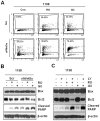Wnt5a is associated with cigarette smoke-related lung carcinogenesis via protein kinase C
- PMID: 23349696
- PMCID: PMC3549912
- DOI: 10.1371/journal.pone.0053012
Wnt5a is associated with cigarette smoke-related lung carcinogenesis via protein kinase C
Abstract
Wnt5a is overexpressed during the progression of human non-small cell lung cancer. However, the roles of Wnt5a during smoking-related lung carcinogenesis have not been clearly elucidated. We investigated the associations between Wnt5a and the early development of cigarette smoke related lung cancer using human bronchial epithelial (HBE) cells (NHBE, BEAS-2B, 1799, 1198 and 1170I) at different malignant stages established by exposure to cigarette smoke condensate (CSC). Abnormal up-regulation of Wnt5a mRNA and proteins was detected in CSC-exposed transformed 1198 and tumorigenic 1170I cells as compared with other non-CSC exposed HBE cells. Tumor tissues obtained from smokers showed higher Wnt5a expressions than matched normal tissues. In non-CSC exposed 1799 cells, treatment of recombinant Wnt5a caused the activations of PKC and Akt, and the blockage of Wnt5a and PKC significantly decreased the viabilities of CSC-transformed 1198 cells expressing high levels of Wnt5a. This reduced cell survival rate was associated with increased apoptosis via the down-regulation of Bcl2 and the induction of cleaved poly ADP-ribose polymerase. Moreover, CSC-treated 1799 cells showed induction of Wnt5a expression and enhanced colony-forming capacity. The CSC-induced colony forming efficiency was suppressed by the co-incubation with a PKC inhibitor. In conclusion, these results suggest that cigarette smoke induces Wnt5a-coupled PKC activity during lung carcinogenesis, which causes Akt activity and anti-apoptosis in lung cancer. Therefore, current study provides novel clues for the crucial role of Wnt5a in the smoking-related lung carcinogenesis.
Conflict of interest statement
Figures





References
-
- Hecht SS (2003) Tobacco carcinogens, their biomarkers and tobacco-induced cancer. Nat Rev Cancer 3: 733–744. - PubMed
-
- Alberg AJ, Ford JG, Samet JM (2007) Epidemiology of lung cancer: ACCP evidence-based clinical practice guidelines (2nd edition). Chest 132: 29S–55S. - PubMed
-
- Hoffmann D, Hoffmann I, El-Bayoumy K (2001) The less harmful cigarette: a controversial issue. a tribute to Ernst L. Wynder. Chem Res Toxicol 14: 767–790. - PubMed
-
- Huang RY, Chen GG (2011) Cigarette smoking, cyclooxygenase-2 pathway and cancer. Biochim Biophys Acta 1815: 158–169. - PubMed
Publication types
MeSH terms
Substances
LinkOut - more resources
Full Text Sources
Other Literature Sources
Medical

